Mexican Wolf Foster Parents Get the Job Done
Inside the re-wolfing of New Mexico’s Gila Forest
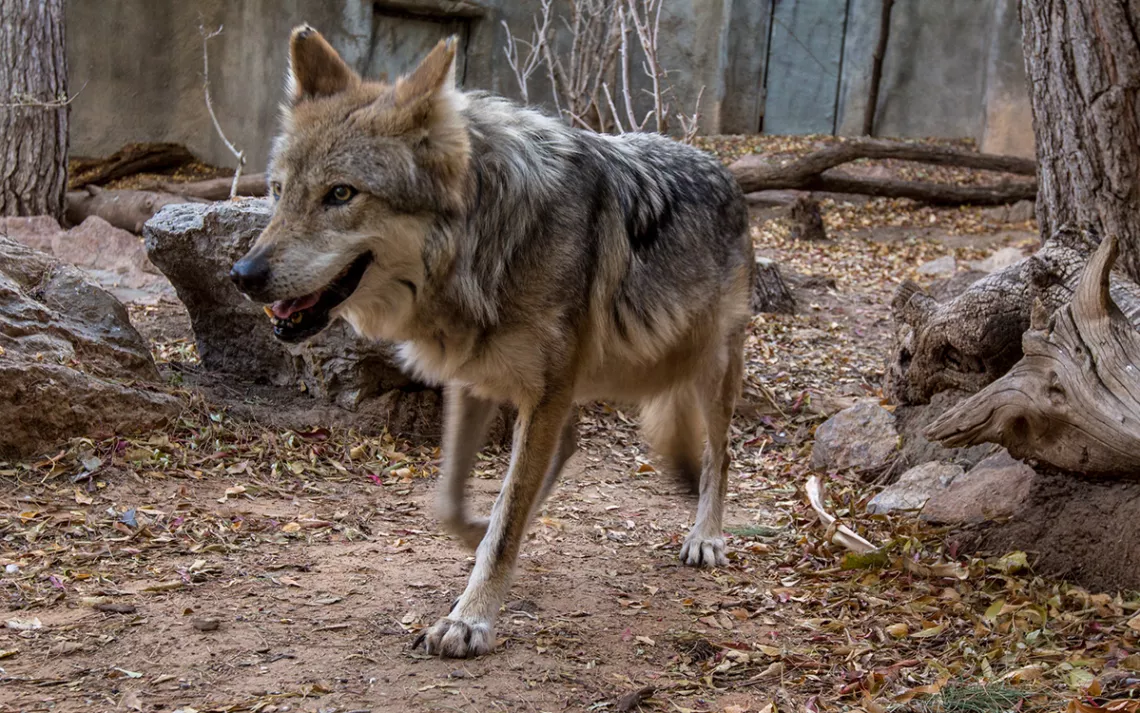
Photos by April Reese and Christina Selby
The matriarch of the Leopold Pack—known to Mexican wolf biologists as Alpha Female 1346—began life as an experiment. Days after she was born in May 2014, biologists snuck the cinnamon-hued pup and her brother into the den of a wild wolf pack in New Mexico’s Gila National Forest, nestled them among the family’s own trio of tawny newborns, then tiptoed away.
At the time, bolstering the Mexican wolf population with cross-fostered pups—offspring that are typically born in captivity then placed into wild dens—was a risky gamble. Biologists had little idea whether the mother wolf would accept the newcomers. But, to their relief, it worked: The mother wolf adopted the foster pups as her own. And the novel experiment was a turning point in the decades-long effort to restore Mexican wolves—the world’s rarest type of gray wolf—to their native territory in the American Southwest.
A relatively small, reddish-brown subspecies of gray wolf, the Mexican wolf (Canis lupus baileyi) once ranged far and wide across parts of Mexico, Texas, Arizona, and New Mexico. By the early 1970s, though, an aggressive eradication campaign by ranchers and the federal government had wiped out Mexican wolves north of the US-Mexico border. Federal biologists reintroduced the predators in 1998, but while their larger and better-known cousins in the northern Rocky Mountains and upper Midwest multiplied, Mexican wolves in the Southwest struggled. Years of setbacks—including failed releases of captive-bred adults, a shallow gene pool, low reproduction rates, illegal shootings, legal culling, and a deep regional antipathy toward both wolves and the federal government—have made the Mexican wolf program one of the most fraught recovery efforts the US Fish and Wildlife Service has ever undertaken.
Now, more than two decades after wolves trotted back into the Southwest, the population’s fortunes are finally beginning to improve. During an annual census last winter, biologists counted 186 wolves in Arizona and New Mexico—a 14 percent increase from the previous year’s count of 163, itself a 24 percent gain over the winter of 2018–2019. The population, which has grown each year for the past five years, is now the largest it's been since reintroduction efforts began and is more than halfway to the Fish and Wildlife Service’s goal of 300 to 325 animals living in the wild.
The cross-fostering program made all the difference. “In the last five or six years, there’s been some really significant growth,” says Stewart Liley, who heads the Wildlife Management Division of the New Mexico Department of Game and Fish, part of the Mexican wolf interagency field team. "We’re seeing lots of pairs, lots of pups.”
Yet in an irony not lost on the architects of the Mexican wolf’s revival, the more that wolves succeed, the more they may be at risk. While 2020 was a record year for wolf numbers, it was also a near-record year for the number of livestock killed by wolves: 157 in all, with 105 in New Mexico and 52 in Arizona. Five of the “problem wolves” were, in turn, killed by federal agents. And if the Mexican wolf population meets the Fish and Wildlife Service's target, the carnivores risk losing endangered species protections before local communities are ready to accept their presence. For AF 1346 and other Mexican wolves to truly thrive in their homelands, biologists must weigh their well-being with that of the humans who now share their home.
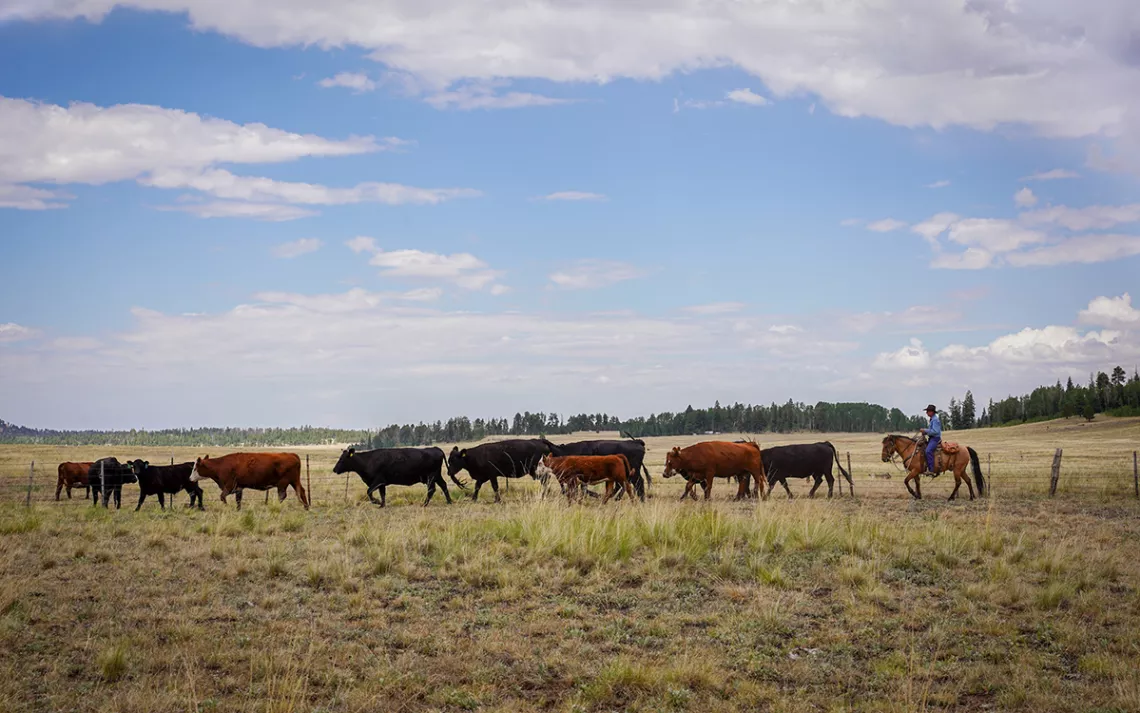
A herd of cattle grazing. | Photograph by April Reese
The 1.7-million-hectare (4.2-million-acre) greater Gila ecosystem, which straddles the Arizona-New Mexico state line and envelops the headwaters of the Gila River, is some of the wildest country remaining in the American West. A luminous sweep of steep mountains, spruce and ponderosa pine forests, shrub-studded mesas, and canyons carved from volcanic tuff, the Gila is sometimes called the Yellowstone of the South. Aside from the tribal lands of the White Mountain Apache and the San Carlos Apache, much of it is federally owned. The Gila National Forest in New Mexico stretches into the Apache-Sitgreaves National Forest in Arizona, creating one vast swath of public lands, punctuated by private ranches and tiny towns with names like Eager and Reserve.
It’s a region rich in wildlife but also home to thousands of cattle. Here, as in much of the West, livestock are raised on a mix of private and public lands; most ranchers lease pastures from the Forest Service. These semi-arid lands require more forage per animal, but unlike in the colder climes of the northern Rockies, herds can calve year-round.
Over thousands of years of breeding for traits like docility and weight gain, domesticated cattle have largely lost their ability to defend against predators, which makes them easy targets for wolves. Losing just one cow to a wolf can cost a rancher $3,000. So when Mexican wolves were extirpated from the United States in the 1970s, many Southwestern ranchers were relieved: They no longer had to worry about the region’s top predator eroding their already-thin profit margins.
That changed in the spring of 1998, when the federal government established the 17,752-square-kilometer (6,854-square-mile) Blue Range Wolf Recovery Area along the Arizona-New Mexico border. Under a special designation in the Endangered Species Act designed to make the reintroduction of controversial species more palatable, Mexican wolves were granted “experimental, nonessential” status, meaning that federal agents can legally kill wolves that attack livestock. But even before the first 11 wolves were let loose in Arizona in 1998, the mere idea of resurrecting a threat that had only recently been vanquished riled local ranchers, many of whose families had run cattle there for generations. In a sign of the troubles to come, four of the wolves released in 1998 were illegally shot.
With that complicated local history and a mosaic of land uses across the Mexican Wolf Experimental Population Area, wildlife biologists and managers knew that recovery would be fraught. Indeed, in the program’s first decade, several successive releases of adult wolves raised in captivity in Arizona failed; the wolves either produced no offspring or developed a taste for beef instead of elk and had to be killed. Others perished under mysterious circumstances, the victims of private coyote traps or private guns. All the while, environmental groups and ranchers sparred in court. Environmental groups repeatedly sued the Fish and Wildlife Service to expand the recovery zone and stop lethal removals, while ranchers sued to quash the program.
Finally, around 2010, Mexican wolves began to gain a foothold on recovery. While the population numbered only 50 wolves that year, it began to inch upward. By 2015, the growth rate rivaled that of wolves in Yellowstone. The Fish and Wildlife Service upped its population target to 325 wolves, and New Mexico agreed to join Arizona in allowing captive wolves to be released. Two years later, the recovery plan was updated. It called for adding another wolf pack in Mexico, plus releasing additional captive animals into the wild.
Yet wolf biologists worried about the populations’ prospects. Wolves were still dying by human hands; in 2018 alone, 21 were found dead. Captive-bred wolves released as adults were especially likely to target cattle and wind up in trouble. A lack of genetic diversity also hampered the populations’ long-term prospects. This convergence of problems prompted biologists to try a new tack: introducing captive-born pups and duping wild Mexican wolf mothers into caring for them.
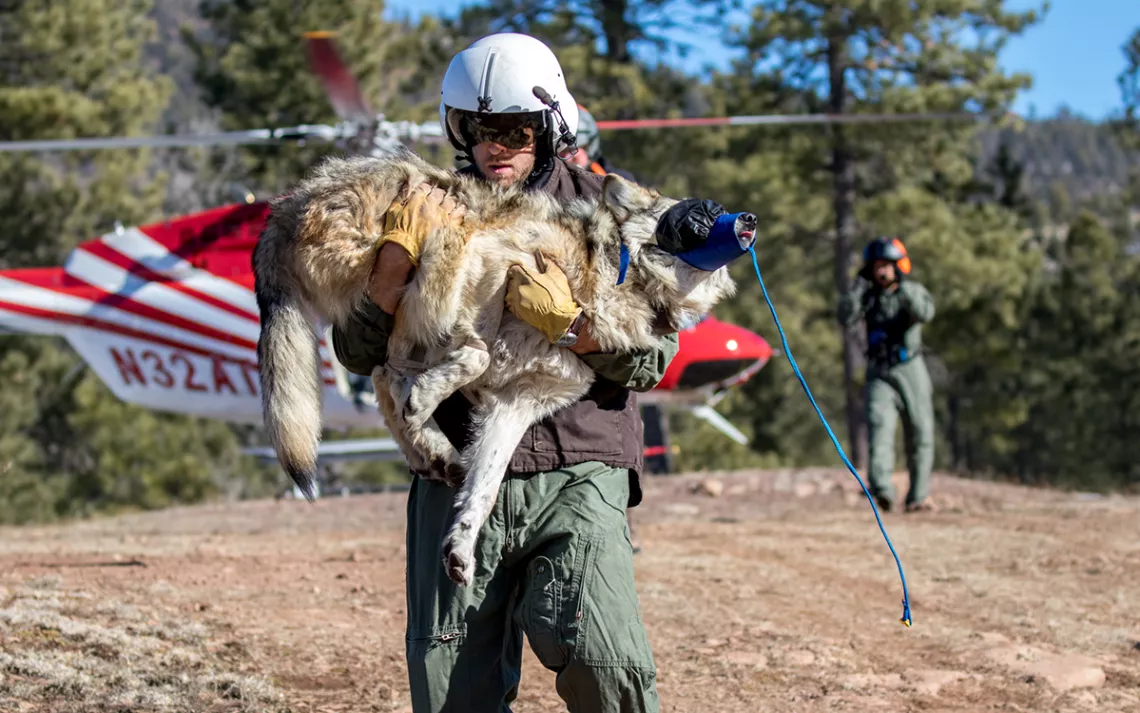
Mexican wolf #M1296 is carried from a helicopter to the Alpine, Arizona, field office to be processed by biologists before being returned to the location where he was captured. | Photograph by Christina Selby
Deputy Mexican Wolf Recovery Coordinator Maggie Dwire remembers the story of Alpha Female 1346 well. It was 2014, the first year of the pup cross-fostering program and Dwire's team had decided to try transferring two wild-born pups from one pack to another before trying it with captive-born pups, a more challenging proposition. The team moved two weeks-old wolves, a female and a male, into the Dark Canyon Pack near the Gila Wilderness. Those pups were 1346 and her brother, 1347. With the successful adoption of the siblings, the cross-fostering program was born. Today, biologists mostly place captive-bred pups with wild parents.
The influx of genes from the captive population is crucial to Mexican wolf recovery. All Mexican wolves alive today are part of the same small family, tracing their ancestry to just three lineages. A few years after Mexican wolves were listed under the Endangered Species Act in 1976, the last seven known Mexican wolves were taken from Mexico to the US to start a captive-breeding program. Three of those wolves reproduced, and their descendants were bred with wolves rescued from a roadside attraction in northern New Mexico and another captive pair found in Mexico. The 11 wolves introduced into Arizona in 1998 were all descendants of these founders.
With such a small gene pool, biologists worried about inbreeding from the start. “The low gene diversity, the very low number of effective founders, and the high mean kinship of Mexican wolves in the reintroduced population appear to be as extreme as in any reintroduced population of an endangered species, and portend severe genetic problems,” wrote wolf geneticist Philip Hedrick, professor emeritus at Arizona State University, in 2018.
To ensure that coveted genes of underrepresented lineages infiltrate the packs that need them most, biologists have devised one of the world’s most carefully planned matchmaking programs. Each year, several months before the spring breeding season, wolf biologists and managers converge with copies of the Mexican wolf studbook in hand—a family tree of sorts that lists the ancestry of every collared wild wolf and captive wolf. After careful review, the group decides which captive wolves will be paired, based on which couplings will produce pups with the genes that wild packs need most. (There is more diversity in the 350-member captive population than in the wild, because captive coupling can be carefully controlled, while wild wolves choose their own mates.)
If all goes well, the pairs produce pups in April, and the cross-fostering machine lurches into motion. The tiny pups are flown to the recovery zone from captive-breeding facilities around the country. Once there, after the unsuspecting foster parents have left the den, biologists carry the pups—small enough to cradle in cupped hands—in backpacks to a staging area downslope from the den site. Meanwhile, other team members pilfer the wild pups from the den and bring them to the staging area. “It’s a little bit scary, because you have neo-natal pups who are dependent on you,” says Dwire. “You have to keep them warm.”
All of the pups are then vaccinated and smeared with the urine of the wild-born pups and detritus from the den, so that they all smell the same to the mother wolf. The new adoptive siblings then go back in the backpacks and back to the den, where they’re all nestled together.
The mothers aren’t completely fooled; they seem to recognize that there are foreign pups in their brood but quickly adopt them as their own anyway. Dwire and her team make sure to place the pups with experienced mothers, whose offspring are more likely to survive than those of first-time moms. They also choose packs with a proven track record of pursuing natural prey, like elk, rather than livestock. And they try to cross-foster pups into areas where the nearest rancher is more receptive to sharing the landscape with wolves.
All of this must be done within a two-week window just after pups are born. The effort requires a sophisticated logistical operation, not unlike an emergency-response mission. It also requires an adventurous spirit.
“It can be pretty physically demanding, crawling into these dens,” says Paul Greer of the Arizona Department of Game and Fish. Mexican wolves like to create dens on slopes, he says, and “some are quite deep. You might have to push back some feelings of claustrophobia.”
Earlier this spring, a record 22 pups were placed in wild dens. The survival of those pups—and the coveted genes they carry—will help determine their species' survival.
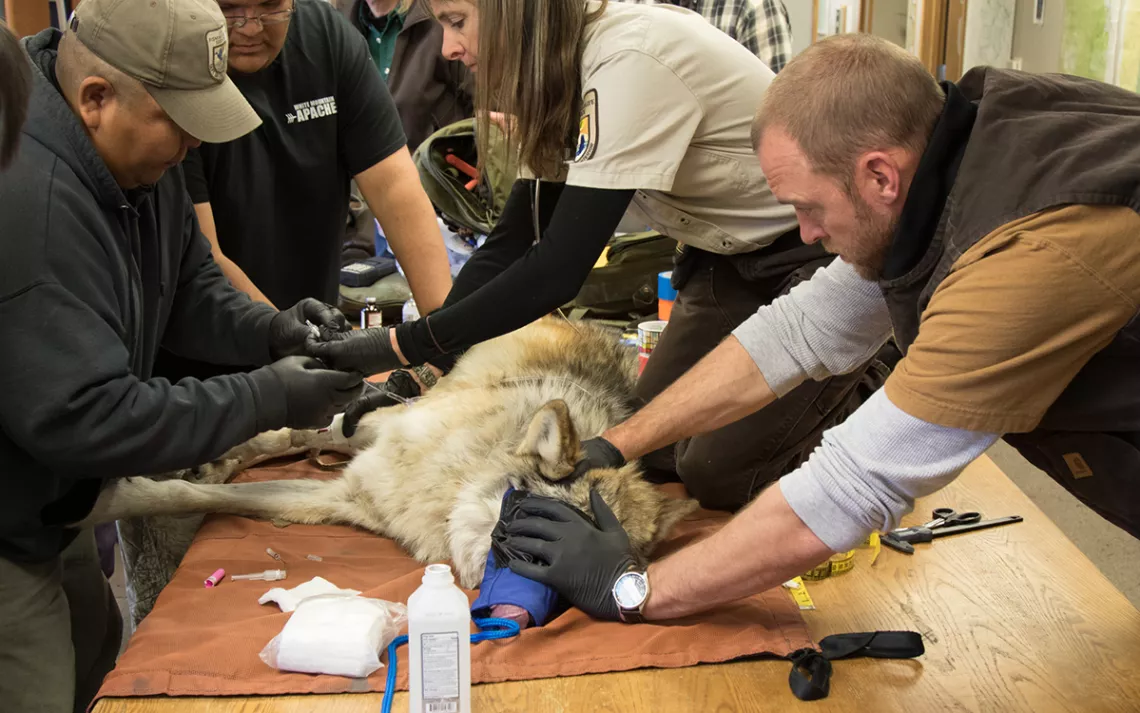
Interagency field team members from the White Mountain Apache Tribe of Arizona, Arizona Game and Fish, and the USFWS administer vaccinations, take blood samples, and refit wolf #M1296 with a GPS collar. | Photograph by Christina Selby
AF1346 is one of the luckier wolves in the American Southwest. After surviving to adulthood and finding a mate, the wolf, whose coat matured to a reddish-brown flecked with black and white, chose to settle in the northern reaches of New Mexico’s Gila Wilderness, where livestock grazing is restricted and the only human presence is on foot. Hers was the first pack to naturally colonize the recovery area, rather than being translocated like its predecessors.
Their arrival was such a momentous occasion that biologists gave the pack a special name, one it had reserved for the wolves they hoped would one day build a home there. They called it the Leopold Pack, in honor of iconic conservationist Aldo Leopold, who proposed establishing the Gila Wilderness—the world’s first protected wilderness area—in 1924. It was Leopold’s encounter with a Mexican wolf there that upended his view of predators and profoundly shaped his land ethic, which in turn shaped federal environmental policy for decades to come.
“In those days, we had never heard of passing up a chance to kill a wolf,” Leopold recalled in A Sand County Almanac. Fewer wolves meant more deer and elk for hunters like himself, he thought then. But after shooting a wolf and watching the “fierce green fire” in her eyes fade, he wrote, “I realized then and have known ever since that there was something new to me in those eyes, something known only to her and to the mountain.… I sensed that neither the wolf nor the mountain agreed with such a view.”
Living up to its name, the Leopold Pack has thrived. To biologists’ knowledge, none of its members, including AF1346, have ever attacked livestock.
Just a few miles to the northwest, the Prieto Pack met a very different fate. It settled in some of the best wolf habitat in the recovery zone, but its territory overlapped with a large grazing allotment, and some of the wolves learned that calves and aging cows are easy prey. Hoping to break the animals of the habit, biologists left caches of food away from grazing areas and hazed the wolves. The rancher even hired a range rider to keep an eye on the herd. But the predations kept coming.
In 2018, the Prieto Pack consisted of an alpha male—born the same year as the Leopold Pack’s matriarch—and an alpha female, another adult female, and two male pups. By spring 2020, they were all gone. One female was fatally caught in a trap. A pup was found dead; its death is under investigation. Soon after, two males were “lethally removed,” according to Fish and Wildlife Service notices. The pack had been responsible for 12 confirmed livestock attacks over the previous six months. The Prieto Pack was no more.
While Mexican Wolf Recovery Coordinator Brady McGee says that lethal removal is “a last resort,” the fate of the Prieto Pack’s members is not unusual. Federal agents have killed 20 wolves since reintroduction began, and at least two dozen more have died from injuries related to recapture. Most, though, have died from illegal killings: Between 1998 and 2015, at least 66 wolves perished from illicit shooting and trapping by members of the public.
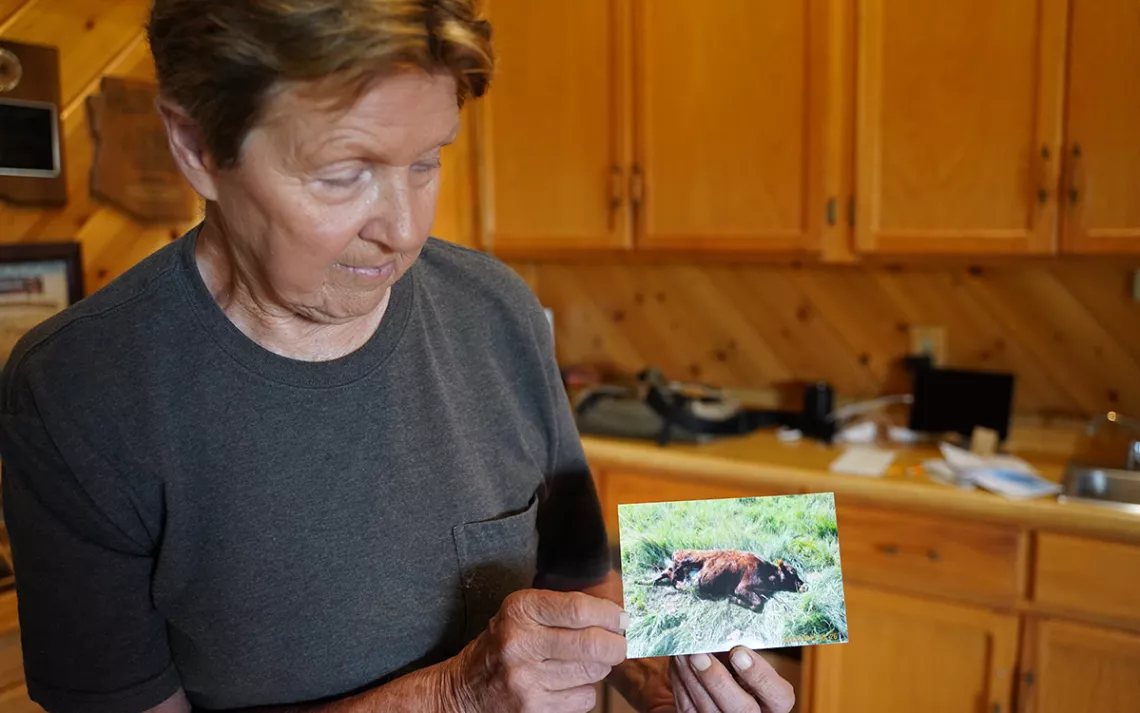
Rancher Wink Crigler, whose family has raised cattle near Eager, Arizona, for generations, holds a picture of a calf killed by a wolf in her yard in 2019. "There’s no such thing as coexistence,” she says. | Photograph by April Reese
While adorable, wild-raised foster pups may take some of the edge off wolf reintroduction, Dwire and other wolf managers have learned that easing the acrimony over the predator’s comeback requires a constellation of strategies. Key among them is compensation for ranchers who lose animals to wolves. Not all ranchers take advantage of these programs; some fear that accepting recompense for livestock losses will be seen as tacit approval of the reintroduction program.
Wink Crigler, who runs 280 cows on a ranch near Eager, Arizona, has no problem accepting the money. But after losing several animals to wolves—including a full-grown cow last year and a calf in her own yard in 2019—Crigler now does everything she can to keep from having reason to. She employs a range rider whose primary job is to keep track of where the wolves are and where the livestock are, and to keep the two apart. During calving season, she trucks her cows to safer pastures two hours away, an expensive undertaking.
“You wouldn’t throw Fifi into a den of lions, and it’s the same way with your livestock,” she says. “We tend now to avoid high-risk areas with wolves.”
Crigler’s range rider, Jay Brad Miller, employs a combination of cowboy instincts, technology, and pure vigilance to keep cows and wolves apart. On a mesa several miles from Crigler’s ranch, he parks his white Dodge truck along the dirt road and jumps out next to a pasture edged by ponderosa pines. It’s July, and about a dozen cows graze on tufts of Arizona fescue and mountain muhly, fed by a nearby spring, their stalks an unlikely shade of emerald in the relentless drought. Miller raises a black antenna into the warm July air, presses a brick-size receiver to his ear, and listens. Taped on the back is a list of numbers assigned by wildlife officials, each representing a GPS-collared wolf. “The monitor really helps us keep track of the wolves so we can help avoid conflict,” Miller says.
Miller—his brown felt cowboy hat shading a Sam Elliott mustache—listens intently for a while. The only sounds are occasional laughter and shouts from a circle of RVs parked on the edge of the pasture: pandemic exiles. “Nothing,” he says, lowering the receiver. He dials in another frequency, another wolf. Then another. And another. Still nothing.
Later, switching from horsepower to horse, he rides across a larger pasture farther down the road, helping a neighbor and his chocolate lab, Bess, nudge a young cow back to the right side of the fence. Cow safely returned, Miller looks out over the land from his saddle, toward Escudilla Mountain in the distance. Wolves were spotted here a few years ago, but today, all is quiet. The cows are safe.
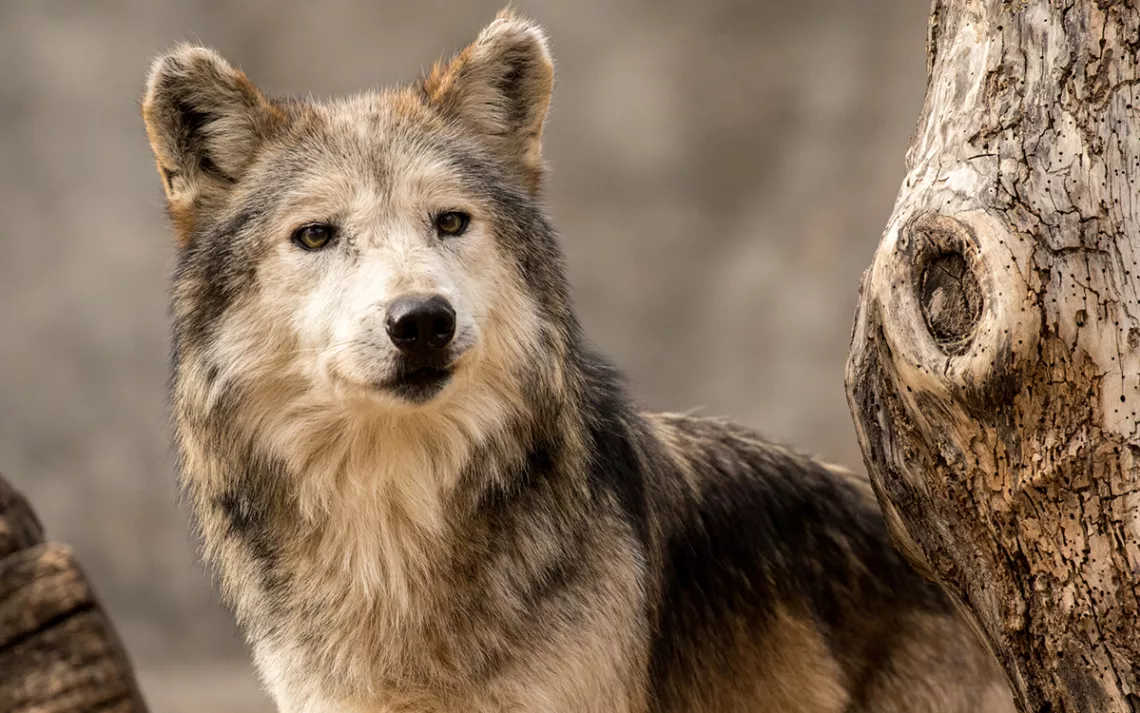
A Mexcian wolf at the El Paso Zoo. | Photograph by Christina Selby
Although Crigler is one of the most proactive ranchers in the region, she’s far from happy about having to invest so much time and money to keep her cows safe. "There’s no such thing as coexistence,” she says, sitting in a spacious room on her ranch that she’s converted into a mini-museum of western memorabilia: a saloon-style player piano; a Victorian dress; local newspaper clippings about John Wayne, who owned a 50,000-acre cattle ranch down the road. “A wolf is going to eat. Somebody’s going to die. And that is not the definition of coexistence.”
Despite lingering antipathy from many ranchers, tolerance for wolves in the Southwest seems to be on the rise and may be bolstered by another new move by the federal government. In 2019, Congress approved $1.4 million in funding for nonlethal conflict-avoidance strategies. That means Wildlife Services can now install electric fencing and hire range riders rather than just kill problem wolves. “That’s huge,” says Bryan Bird, Southwest program director for Defenders of Wildlife. “It's so exciting to see the federal government step in with actual funding for this work.”
Another possible—and likely more controversial—game-changer is the Fish and Wildlife Service’s court-ordered rewrite of its Mexican wolf management plan. Environmental groups and biologists have sent the agency a wish list: Release captive wolf pairs with pups, lift the cap on how many wolves are allowed in the wild, and stop killing wolves that prey on livestock in areas where ranchers haven’t taken the initiative to remove the carcasses of cows that have died from other causes. The Fish and Wildlife Service is due to release its revised rule in July 2022.
Back in the Gila, state and federal biologists have just finished sneaking the next generation of foster pups into their new homes—a record 22 young wolves released from captivity into the wild. And biologists continue to keep tabs on their predecessors: Of the pups fostered by wild packs last year, biologists documented seven survivors—comparable to the first-year survival rate for wild-born pups.
And somewhere amid the gold-green ponderosa pines of the Gila Wilderness, AF1346, now seven years old, is hunting elk with the newest members of her own pack. Last year, she gave birth to pups of her own, making her the first foster pup to successfully reproduce.
This story originally appeared in bioGraphic, an online magazine about nature and sustainability powered by the California Academy of Sciences.
 The Magazine of The Sierra Club
The Magazine of The Sierra Club



